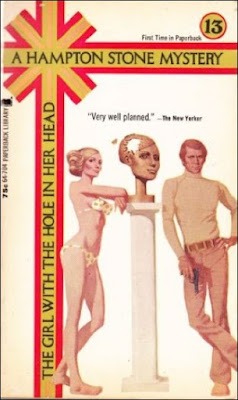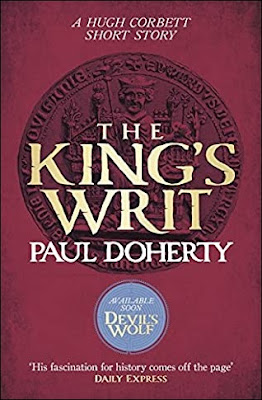Last month, I reviewed The Real Gone Goose (1959) by Aaron Marc Stein, a prolific American crime-and detective writer, who produced over a hundred novels under his own name as well as two pseudonyms, "George Bagby" and "Hampton Stone" – all published between 1935 to 1984. I concluded the review with the observation that Stein consistently churned out entertainingly written, serviceable plotted detective stories possessing an ever-present glimmer of greater things. Judging from what I gleaned of Stein's writing and career, he rarely, if ever, delivered greater things. You can likely put that down on his productivity and having to meet deadlines, but The Corpse Who Had Too Many Friends (1953) and The Real Gone Goose were enough to push him back into my peripheral. However, I'm always open to suggestions that could prove me wrong (e.g. The Kindaichi Case Files), but the subject of today's review kind of lucked its way into my hands.
The Girl with the Hole in Her Head (1949), published as by "Hampton Stone," is the second entry in the series about New York's Assistant District Attorney, Jeremiah X. "Gibby" Gibson. This is only title in the series that had been jotted down on my wishlist, because Robert Adey listed it in Locked Room Murders (1991). So can a full-blown locked room puzzle deliver greater things and turn The Girl with the Hole in Her Head into something more than an entertainingly written, serviceable plotted detective story? Yeah, kind of, but not on account of "bolted rooms and gimmicks like that."
Ellen Bannock is the titular girl with the hole in her head, "a sweet child but quite mad," who nearly died in car crash and would have died had it not been for the miracle of modern surgery – patching the hole in her head with a metal plate. She lives under somewhat curious circumstances with her dysfunctional siblings and assorted live-in friends in a slick, modern three-story house on East End Avenue. Ellen Bannock has a half-brother and step-brother, David and Gordon Cameron ("Gordon was his. I was hers. David was theirs"). David Cameron is an alcoholic wreck and a friend from Alcoholic Anonymous, "some character name of Edwards," is living in their guestroom. Gordon Cameron is the head of the rich, successful head of the family, but without any real friends beside a special secretary and companion. Paul Morrison, "man-of-all-work," is there to take care of all the little, day-to-day annoyances and playing sports with Gordon ("...Gordon is a special person and Paul's job is made to order to fit Gordon"). Austin is another resident guest and somewhat successful sculptor who crafted the wire and glass rod arrangements on the hall walls. But he also made a sculpture of Ellen's head with a great jagged hole, which stands on a pedestal in a most prominent position ("...another touch of madness in a completely mad household").
So while the household can be described as unusual, even slightly dysfunctional, it's not a completely loveless household. When anonymous threats begin to arrive at the house, Ellen tries to intervene.
All the threats were addressed to Gordon, but he refuses to take them seriously and can't even be bothered to open them anymore. So now he tears them to pieces unopened, and unread, but, when he found out Ellen was putting them back together, he simply burned them. Ellen turned to the District Attorney, The Old Man, who in turn puts his two assistants on the case. But can she be trusted? Jeremiah X. Gibson and Malcolm T. Macauley, simply Gibby and Mac, receive instructions to humor her, but not to believe a word she says. Gibby and Mac begin a discreet investigation behind Gordon's back as they try to get their hands on the ashes of a burned letter. And then there's the curious incident of the birdcage. But things had gone "too far for them to have boiled out to anything but murder." More on that locked room murder in a minute.
Mike Grost notes on his website, A Guide to Classic Mystery and Detection, that Stein's detective novels "are vaguely Van Dine-ish in approach" and that's certainly true for The Girl with the Hole in Her Head. Firstly, the series and this book is narrated by Mac, but he merely records what happens and is barely acknowledged. Mac is only mentioned by name a handful of times through out the story. So very much a Van Dinean narrator. Secondly, there's the slightly cracked family living together and Gordon's private, soundproof study doubling as a private museum so often found in Van Dine and his followers. Gordon's study houses a very peculiar and personal collection, but it takes a while before Gibby and the reader get to meet Gordon. And experience the bizarre collection ("one was assaulted by their total effect"), which is the most striking scene in the whole book. A mad touch of Ellery-in-Wonderland! There is also an unmistakable influence of the hardboiled detective story mixed into the narrative. Grost points out that "their District Attorney boss is called the Old Man like the boss of the detective agency in Dashiell Hammett's Continental Op tales," but I only noticed lines like "he [Gibby] just can't get it through his head that they [influential people] aren't people like anyone else, subject to the same laws." Gibby has a tendency to forget about "the limitations the law puts upon the powers of the public prosecutor's office" and can be "dynamite with influential people," which includes bending the rules a little as shown in The Corpse Who Had Too Many Friends – making him the legal counterpart to Erle Stanley Gardner's Perry Mason. Mac's primary job in the series is curbing Gibby's unfortunate tendencies and stop him from stepping on too many toes. It feels like a very pulpy setup.
Gordon Cameron is eventually found dead, shot in the chest, in his study, but the door is bolted from the inside and all the windows latched. There were two hired guards posted at the front and rear doors. However, there's not much more to say about the locked room problem, because a solution is immediately proposed and accepted. Fortunately, the locked room-trick has a small twist in its tail and Gibby amusingly tries to find out who in the house has read the detective novel entitled Murder Behind the Bolted Door ("complete explanation of the... trick in the last chapter"). A copy of which was found somewhere in the house. So more interesting in how the murderer employs the concept of a locked room mystery than any kind of ingenious trickery or sleight-of-hand as the trick is fairly routine. Not something you can say of either the who-and why.
The Girl with the Hole in Her Head is a second-string (or mid-list) detective tale, but the identity of the murderer is not half as obvious as it would have been in the hands of a less talented second-stringer. The murderer's identity is strengthened with a good and convincing motive, which is not a run-of-the-mill reason and one that arose from a very specific set of circumstances. All of it's relatively fairly clued. My only (very minor) misgivings is that a Dying Message puzzle would probably have served the plot better than a locked room and fitted the Van Dine-Queen furnishings of the plot and characters. Other than that, The Girl with the Hole in Her Head proved to be a better, more consistently plotted, detective story than either The Corpse Who Had Too Many Friends or The Real Gone Goose. So glad my initial impressions from them do not entirely hold up and rekindled my intention to track down his archaeological mystery series or continue poking around this series. The Murder That Wouldn't Stay Solved (1951), The Corpse That Refused to Stay Dead (1951) and The Strangler Who Couldn't Let Go (1957) all sound promising enough.
















